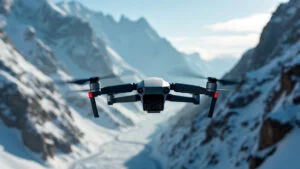Introduction
Innovation plays a crucial role in modern wildlife conservation, and one of the most groundbreaking advancements in recent years is the use of real-time satellite tracking. For species like the snow leopard, which inhabit remote and rugged terrains, satellite tracking offers a revolutionary way to monitor their movements and behaviors with unprecedented accuracy
This article delves into the technology behind satellite tracking, its specific application in snow leopard conservation, and the innovations that are enhancing its effectiveness. We’ll also explore the benefits and challenges of using this technology and how it is shaping the future of snow leopard conservation efforts
What Is Real-Time Satellite Tracking in Wildlife Conservation?
Real-time satellite tracking represents a cutting-edge innovation in wildlife conservation, providing conservationists with the ability to monitor animal movements and behaviors remotely with high precision
This technology involves fitting animals with GPS-enabled collars that transmit their location data via satellite networks, allowing researchers to track their movements in real time
The use of satellite tracking has revolutionized the study of many elusive and endangered species, including the snow leopard, by offering insights that were previously unattainable through traditional methods
Definition and Importance of Satellite Tracking
Satellite tracking refers to the use of satellite technology to collect and transmit data on the location and movement of animals fitted with tracking devices. These devices, often in the form of GPS collars, use signals from satellites orbiting the Earth to determine the precise location of the animal
The data collected is then transmitted to researchers via satellite communication networks, enabling real-time monitoring of the animal’s movements
The importance of satellite tracking in wildlife conservation cannot be overstated. This technology allows conservationists to gather detailed information about the movement patterns, habitat use, and behavior of animals in their natural environments
For species like the snow leopard, which are notoriously difficult to observe due to their elusive nature and the remote, rugged terrains they inhabit, satellite tracking provides invaluable data that informs conservation strategies and helps protect these endangered predators
Technological Components of Satellite Tracking
Satellite tracking systems are composed of several key components: the GPS-enabled collar, satellite networks, and data transmission and analysis platforms:
GPS-Enabled Collar: The GPS collar is the primary tracking device attached to the animal. It contains a GPS receiver that picks up signals from multiple satellites to calculate the animal’s location with high accuracy. These collars are designed to be lightweight and durable, minimizing discomfort for the animal while ensuring reliable performance in harsh environmental conditions
Satellite Networks: The collars rely on satellite networks, such as the Global Positioning System (GPS) or the Global Navigation Satellite System (GNSS), to determine the animal’s location. These networks consist of satellites orbiting the Earth that continuously broadcast signals to the GPS receivers on the collars. By triangulating signals from multiple satellites, the receiver can accurately pinpoint the animal’s position
Data Transmission and Analysis Platforms: Once the location data is collected, it is transmitted via satellite communication networks to a central database, where researchers can access it in real time. Advanced data analysis platforms allow conservationists to visualize the animal’s movements on digital maps, analyze behavioral patterns, and make informed decisions regarding conservation efforts
Applications in Various Wildlife Conservation Efforts
Satellite tracking has been successfully applied in the conservation of a wide range of species, from migratory birds to marine mammals
For snow leopards, the technology has been particularly transformative, providing critical data that enhances our understanding of their ecology and informs conservation actions
In bird conservation, satellite tracking has been used to monitor long-distance migrations, helping to identify key stopover sites and breeding grounds that need protection. For marine species like whales and sea turtles, satellite tracking provides insights into their migratory routes and habitat use, enabling the creation of marine protected areas
For land mammals like snow leopards, satellite tracking has shed light on their territorial ranges, movement corridors, and interactions with other species. This information is crucial for designing effective conservation strategies, such as creating wildlife corridors that connect fragmented habitats, reducing human-wildlife conflict, and implementing anti-poaching measures
The use of satellite tracking is not limited to individual species; it also has broader applications in ecosystem management. By tracking multiple species within an ecosystem, conservationists can gain a better understanding of ecological dynamics and the impacts of environmental changes, such as climate change or habitat loss
This holistic approach allows for more effective conservation planning and resource allocation, ultimately contributing to the long-term preservation of biodiversity
How Does Satellite Tracking Work for Snow Leopards?
Real-time satellite tracking has become a game-changer in the conservation of snow leopards, offering unprecedented insights into their behavior, movements, and habitat use
This technology allows researchers to monitor these elusive cats across the vast and rugged terrains they inhabit, providing critical data that informs conservation strategies. Understanding how satellite tracking works for snow leopards involves examining the process of equipping them with tracking collars, the data collection and transmission mechanisms, and the practical applications of this technology in the field
Process of Equipping Snow Leopards with Satellite Collars
The first step in satellite tracking snow leopards is the safe and ethical attachment of GPS-enabled collars to the animals. This process begins with the careful capture of the snow leopard, often using humane traps that minimize stress and injury
Once the snow leopard is safely restrained, a veterinarian and a team of researchers work together to fit the collar around the animal’s neck
These collars are designed to be lightweight and robust, ensuring they do not hinder the animal’s natural movements or behavior. The collars are also adjustable, allowing for a secure fit that prevents them from slipping off or causing discomfort
After the collar is attached, the snow leopard is closely monitored as it recovers from any sedation used during the procedure, and once it is fully alert, it is released back into its habitat
The collars are equipped with GPS receivers that continuously track the snow leopard’s location by triangulating signals from multiple satellites
These devices are also designed to withstand the extreme conditions of the snow leopards’ high-altitude habitats, including harsh weather and rugged terrain. Some collars are even equipped with additional sensors that can collect data on the animal’s physical condition, such as temperature and activity levels, providing even more comprehensive information for researchers
Data Collection and Transmission Mechanisms
Once the collar is in place, it begins collecting data on the snow leopard’s movements. The GPS receiver within the collar calculates the animal’s position by receiving signals from a network of satellites orbiting the Earth
This location data is typically recorded at regular intervals, ranging from every few minutes to several times a day, depending on the specific study’s goals and the collar’s battery life
The collected data is then transmitted via satellite to a central database where researchers can access it in real time. This transmission process is crucial for enabling conservationists to monitor snow leopards’ movements as they happen, allowing for immediate responses to any potential threats or changes in behavior
The real-time aspect of satellite tracking is particularly valuable in remote areas where physical monitoring is challenging. Conservationists can track snow leopards’ movements across vast landscapes, identifying key areas such as hunting grounds, breeding sites, and migration corridors. This data is vital for understanding how snow leopards interact with their environment and other species, including prey and competitors
Case Studies of Tracking Snow Leopards in Their Habitats
Several case studies highlight the effectiveness of satellite tracking in snow leopard conservation. For instance, in the mountains of Mongolia, researchers have successfully used satellite tracking to monitor the movements of snow leopards across a large portion of their range
This study revealed important insights into the snow leopards’ territorial behavior, including how they use the landscape and interact with neighboring leopards
In another case in the Indian Himalayas, satellite tracking helped conservationists identify critical habitat areas that were previously unknown. By tracking the movements of several snow leopards over time, researchers were able to map out key regions that are essential for the species’ survival
This information led to the establishment of new protected areas and the creation of wildlife corridors that connect fragmented habitats, ensuring that snow leopards have the space they need to thrive
Satellite tracking has also been instrumental in understanding how snow leopards respond to human activities. In regions where snow leopards’ habitats overlap with livestock grazing areas, tracking data has helped identify potential conflict zones
This information allows conservationists to work with local communities to implement measures that reduce the likelihood of snow leopards preying on livestock, such as improved animal husbandry practices and the construction of predator-proof corrals
These case studies demonstrate the transformative impact of satellite tracking on snow leopard conservation. By providing detailed and accurate data on snow leopards’ movements and habitat use, satellite tracking enables conservationists to make informed decisions that are critical for the long-term survival of this endangered species
As satellite tracking technology continues to advance, it will likely play an even more significant role in protecting snow leopards and other threatened wildlife
Innovations Enhancing Satellite Tracking for Snow Leopards
As technology evolves, so too does the effectiveness of satellite tracking in snow leopard conservation. Recent innovations have significantly enhanced the precision, reliability, and scope of satellite tracking, making it an even more powerful tool for understanding and protecting snow leopards
These advancements include improvements in GPS and satellite communication technology, the integration of real-time data analytics and artificial intelligence (AI), and the development of solar-powered collars with extended battery life
Advances in GPS and Satellite Communication Technology
One of the most critical innovations in satellite tracking for snow leopards is the advancement in GPS and satellite communication technology. Modern GPS collars are more accurate and efficient than ever before, capable of pinpointing the snow leopard’s location within a few meters
This high level of precision is essential for studying snow leopards’ fine-scale movements, such as their hunting patterns, territory boundaries, and interactions with other wildlife
These collars are also more reliable, with enhanced connectivity to satellite networks, ensuring that data is transmitted even from the most remote and rugged terrains. This improvement in connectivity is particularly important in the mountainous regions where snow leopards live, where traditional communication methods might fail
The use of advanced satellite networks, such as those that combine GPS with other global navigation systems, has further increased the availability and accuracy of location data
Additionally, modern collars can store large amounts of data and transmit it in bursts when the satellite connection is strongest, reducing the chances of data loss. This capability allows for more detailed data collection over extended periods, providing a comprehensive view of snow leopard behavior and movement patterns
Real-Time Data Analytics and AI Integration
The integration of real-time data analytics and artificial intelligence (AI) into satellite tracking systems is another significant innovation
With the ability to process vast amounts of data quickly, AI algorithms can analyze movement patterns, identify unusual behaviors, and predict future movements based on historical data. This real-time analysis enables conservationists to make rapid, informed decisions that can have an immediate impact on snow leopard conservation
For example, AI can help identify potential human-wildlife conflict zones by analyzing patterns in snow leopard movements relative to livestock grazing areas. By predicting where a snow leopard is likely to move next, conservationists can take proactive measures to prevent conflicts, such as alerting local communities or deploying deterrents
Real-time data analytics also allow for the continuous monitoring of snow leopard health and behavior. If a snow leopard’s movements suddenly change, indicating potential distress or injury, conservationists can respond quickly to investigate and, if necessary, provide assistance
This capability is especially important in the harsh environments where snow leopards live, where injuries or illness can quickly become life-threatening
Moreover, the combination of AI with satellite tracking data enables more sophisticated habitat modeling and landscape analysis. By correlating snow leopard movements with environmental variables, such as prey availability, weather conditions, and human activities, researchers can gain deeper insights into the factors driving snow leopard behavior and habitat use
This information is crucial for designing effective conservation strategies that address the specific needs of snow leopards in different regions
Solar-Powered Collars and Extended Battery Life
Another innovation enhancing satellite tracking for snow leopards is the development of solar-powered collars with extended battery life. Traditional GPS collars rely on batteries that need to be replaced periodically, which can be challenging and risky when dealing with wild snow leopards in remote areas
The introduction of solar-powered collars has significantly reduced the need for frequent recaptures, allowing for longer monitoring periods and less disruption to the animals
These solar-powered collars harness sunlight to recharge their batteries, making them ideal for use in the high-altitude, open landscapes where snow leopards are often found
The extended battery life provided by solar power means that conservationists can track individual snow leopards over several years, gathering long-term data that is invaluable for understanding changes in their behavior and habitat use over time
Furthermore, the combination of solar power with energy-efficient components in the collars has led to the development of even more compact and lightweight devices. These newer collars are less intrusive, reducing the likelihood of affecting the snow leopard’s natural behavior while still providing high-quality tracking data
This innovation is particularly beneficial in long-term studies aimed at understanding the impacts of climate change and human activities on snow leopard populations. By continuously monitoring the same individuals over extended periods, researchers can observe how snow leopards adapt to changing conditions, such as shifts in prey availability or habitat encroachment, and use this information to guide conservation efforts
Benefits and Challenges of Using Satellite Tracking for Snow Leopards
The use of satellite tracking in snow leopard conservation offers numerous benefits, making it a crucial tool for understanding and protecting this elusive species. However, despite its many advantages, satellite tracking also presents several challenges that conservationists must navigate to maximize its effectiveness
Improved Understanding of Snow Leopard Behavior and Movements
One of the most significant benefits of satellite tracking is the detailed and continuous data it provides on snow leopard behavior and movements
This technology allows researchers to track individual snow leopards across vast and remote areas, gaining insights into their daily activities, territorial ranges, and interactions with other species. Understanding these movement patterns is essential for identifying critical habitats, such as hunting grounds, breeding sites, and migration corridors, which are vital for the survival of snow leopards
Satellite tracking also enables conservationists to monitor how snow leopards use their habitats over time, providing valuable information on how they respond to environmental changes, such as seasonal variations in prey availability or shifts in habitat due to climate change
This data is crucial for developing effective conservation strategies that take into account the dynamic nature of snow leopard ecology
Additionally, satellite tracking has proven invaluable in studying snow leopard dispersal, particularly in young individuals leaving their mothers to establish their own territories. By tracking these movements, conservationists can identify potential corridors that connect different populations, helping to maintain genetic diversity and reduce the risk of inbreeding
Identification of Critical Habitats and Migration Corridors
Satellite tracking plays a critical role in identifying and protecting key habitats and migration corridors for snow leopards
The detailed movement data collected through this technology allows researchers to map out the areas that snow leopards frequent most, such as high-altitude ridges, steep rocky slopes, and remote valleys. These areas are often difficult to access and study using traditional methods, making satellite tracking an essential tool for habitat conservation
By identifying these critical habitats, conservationists can prioritize them for protection, ensuring that snow leopards have access to the resources they need to survive. For example, if tracking data reveals that a particular area is a crucial hunting ground or breeding site, efforts can be made to protect it from human encroachment, poaching, or other threats
Satellite tracking also helps identify migration corridors that snow leopards use to move between different parts of their range. These corridors are essential for maintaining connectivity between populations, allowing for gene flow and reducing the risk of local extinctions
Protecting these corridors is crucial for ensuring the long-term survival of snow leopards, particularly in landscapes fragmented by human activities
Technical and Ethical Challenges in Satellite Tracking
Despite its many benefits, satellite tracking presents several technical and ethical challenges. One of the primary technical challenges is ensuring the reliability and accuracy of the tracking data
While modern GPS collars are highly advanced, factors such as terrain, weather conditions, and satellite availability can sometimes affect the quality of the data collected. For instance, in steep or heavily forested areas, GPS signals may be obstructed, leading to gaps in the data or less accurate location readings
Another challenge is the potential impact of the collars on the snow leopards themselves. Although the collars are designed to be as lightweight and unobtrusive as possible, there is always a risk that they could affect the animal’s behavior, particularly if the collar is too tight or becomes damaged. Ensuring that collars are properly fitted and monitored is crucial for minimizing any negative impacts on the snow leopards
Ethically, the process of capturing and collaring snow leopards raises concerns about the stress and risks involved for the animals. While every effort is made to ensure that the process is as safe and humane as possible, the capture and handling of wild snow leopards can still be stressful and pose risks of injury
Conservationists must carefully weigh the benefits of the data collected against the potential harm to the animals, ensuring that the use of satellite tracking is justified and conducted with the utmost care
Furthermore, the long-term attachment of collars can be a concern, particularly if the collar malfunctions or fails to detach as planned. Most modern collars are designed with automatic release mechanisms that drop the collar after a certain period, but malfunctions can occur, leading to potential discomfort or entanglement for the snow leopard. Regular monitoring and timely interventions are necessary to address such issues
Balancing Technology with Traditional Conservation Methods
While satellite tracking provides invaluable data, it is most effective when used in conjunction with traditional conservation methods
For instance, while satellite tracking can reveal where snow leopards are moving, it does not provide direct insights into their health, prey availability, or social interactions. Combining satellite tracking with field observations, camera traps, and community-based monitoring allows for a more comprehensive understanding of snow leopard ecology
Moreover, satellite tracking data can enhance the effectiveness of anti-poaching efforts. By monitoring the movements of snow leopards in real time, conservationists can identify when an animal is in an area of high poaching risk and deploy resources accordingly
This proactive approach helps protect snow leopards from illegal hunting and trade, which remain significant threats to their survival
Conclusion
Real-time satellite tracking has emerged as a transformative tool in snow leopard conservation, offering unprecedented insights into the movements, behavior, and habitat use of this elusive species. By leveraging advancements in GPS technology, AI integration, and solar-powered collars, conservationists can now monitor snow leopards more effectively across their rugged and remote habitats
While this technology presents certain challenges, such as technical limitations and ethical concerns, its benefits in terms of improved data accuracy and habitat protection are undeniable. As innovations continue to enhance satellite tracking capabilities, this method will play an increasingly vital role in safeguarding snow leopards and ensuring their long-term survival in the wild







